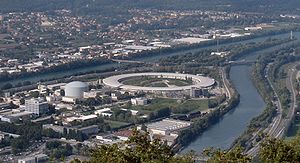European Synchrotron Radiation Facility

The E uropean S ynchrotron R adiation F acility ( ESRF ) is a multinational major research institution based in Grenoble (France). It operates the largest electron synchrotron built specifically for research with synchrotron radiation in Europe, the third largest of its kind worldwide. The circumference of the ESRF electron storage ring is 844 m.
The ESRF is based on a shared site with the Institut Laue-Langevin (ILL) and other institutes, the so-called EPN Science Campus . It employs 600 people and enables around 3,500 scientists to conduct research on the 50 beamlines every year . It is financed by a consortium from 22 partner countries. Among the 13 Member States, France and Germany account for the largest share with 27.5% and 24% of the total budget respectively. 9 other associated countries also have a smaller share of less than 2% each.
The main task of the ESRF is to set up and operate measuring stations and to make these research groups from public institutes and private companies accessible for their purposes. ESRF is thus primarily a "user facility", i. H. the service order is in the foreground. In-house research is also carried out, but is always related to the service contract.
The main areas of activity are a variety of analytical methods:
- Protein structure analysis ,
- other crystallography ,
- X-ray diffraction including small-angle scattering on surfaces and volumes,
- X-ray spectroscopy of various types,
- X-ray micro- and nanotomography, d. H. Computed tomography with microscopic resolution,
- Infrared microscopy.
history
The first plans to build the ESRF were made in the 1970s. Germany and France jointly proposed the project in October 1984, and other countries joined the project in the following years. Construction began on January 1, 1988. On February 17, 1992, electrons were injected into the storage ring for the first time, and in June 1992 the planned beam current of 100 mA was achieved for the first time. The official inauguration took place on September 30, 1994.
In 2008 the ESRF Board of Directors ("Council") approved a comprehensive renewal program ("ESRF Upgrade"). In the first phase (2009–2015) of this program, 19 new experiment stations and an additional experiment hall were built. It had a budget of approx. 177 million euros, of which 74 million came from the regular operating budget of ESRF; for the rest, the member states made special funds available.
The second phase (2015–2022), with a budget of 150 million euros, consisted mainly of a complete renovation of the storage ring. This improved the brilliance and coherence of the X-ray beam by a factor of 100. For this purpose, the experimental operation was interrupted from December 2018. The new beam was tested for the first time at the end of January 2020 - one month earlier than planned. The system should now be available to users again under the name "Extremely Brilliant Source" from August 2020.
Individual evidence
- ↑ What is a synchrotron? ESRF, September 18, 2012, accessed October 3, 2012 .
- ↑ EPN Campus. EPN Science Campus, accessed January 27, 2012 .
- ↑ Find a beamline. ESRF, accessed December 19, 2016 .
- ^ ESRF organization. ESRF, accessed December 19, 2016 .
- ↑ ESRF upgrade programs. ESRF, September 6, 2012, accessed October 3, 2012 .
- ↑ M. Pfalz: The ESRF shines again, Physik Journal Vol. 19 (2020) No. 3, March 2020, page 10
Web links
- Official website
- Detailed description of the ESRF in German on World of Physics
Coordinates: 45 ° 12 ′ 30.5 " N , 5 ° 41 ′ 23.7" E



